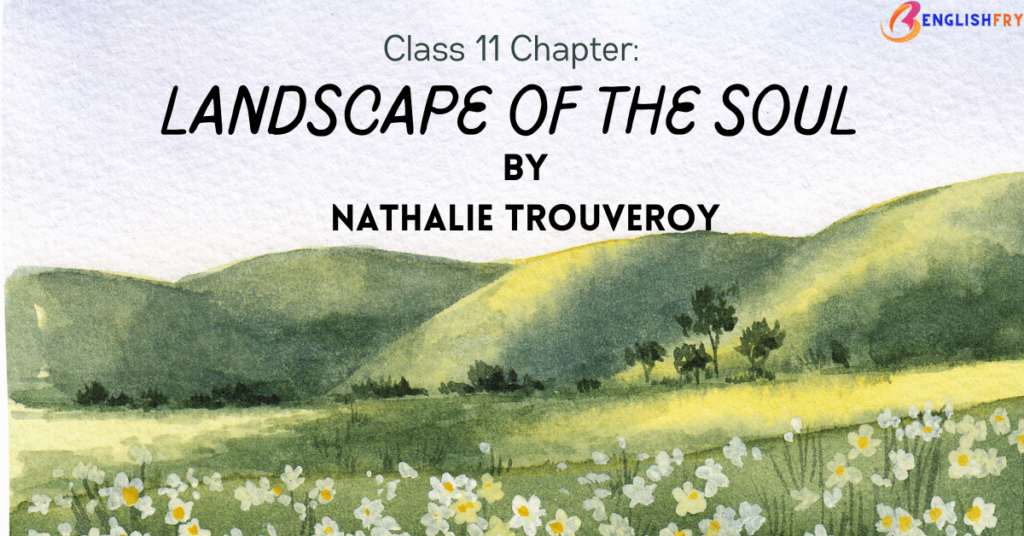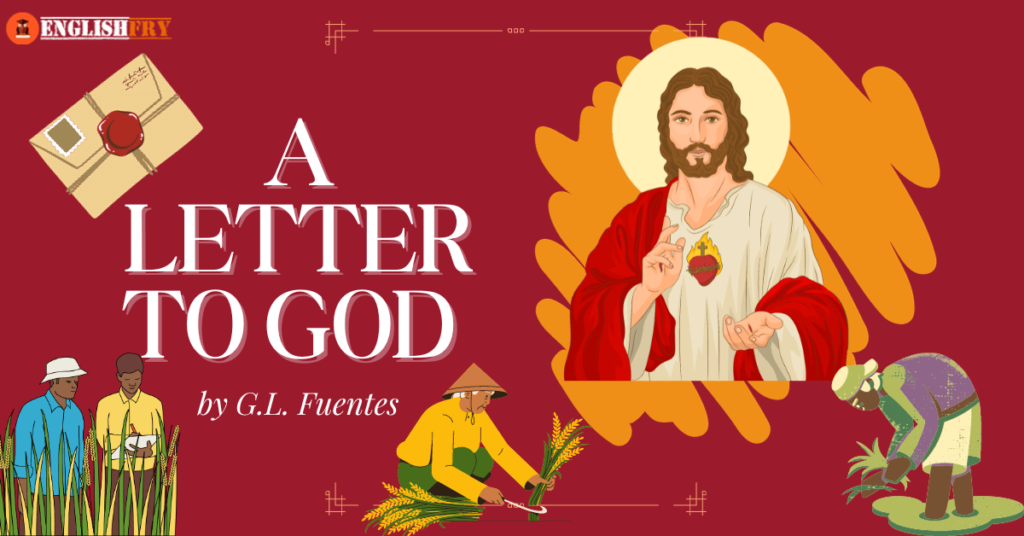Table of Contents
ToggleSummary Class 11 English Chapter 4
INTRODUCTION
Here we are abouit to discusss NCERT Solutions for Class 11 English Chapter 4 – Landscape Of The Soul.Written by Nathalie Trouveroy, the chapter is about how different the Chinese Art form is, from the European art form. The writer uses two stories to contrast. European art is about reproducing an actual view whereas Chinese art is about not creating a real landscape. European art is an artist’s way of letting viewers show exactly what he wants them to see in the landscape. Chinese art is the artist’s spiritual and inner voice where you can travel from any point and it lets the viewer create a path for their imagination.
MEANING
This phrase means that a Chinese painter wants you to enter his mind rather than borrow his eyes. This is a physical as well as a mental participation. It is
a landscape created by the artist to travel up and down, and back again through the viewer’s eyes.
Chinese Vs European View of Art
The Chinese form of art is based on imagination and shows the inner and spiritual approach of the artist. Whereas, the European art form is real and reproduces an actual view of the object from the landscape.
SHANSHUI
Shanshui is a Chinese concept of art that means ‘mountain water’. It is used together to represent the word ‘landscape’. The two complementary poles (yin and yang) of an image reflect the Daoist view.
OUTSIDER ART AND ART BRUT OR RAW ART
Outsider Art is the art made by untrained artists, for example, children or mentally ill people. ‘Art Brut’ or ‘Raw Art’ is a type of art made by people who are not professionals but they create an art piece with depth and understanding and not from the stereotypical form of classical or fashionable art.
UNTUTORED GENIUS
“Untutored genius who created a paradise” was Nek Chand. He was an eighty-year-old creator–director who made the world-famous Rock Garden in Chandigarh. He used everything from a tin to a sink or anything that he felt was an art form. One of his famous creations is ‘Women by the Waterfall’.
“The landscape is an inner one, a spiritual and conceptual space.” The statement ‘The landscape is an inner one, a spiritual and conceptual space’ means that a Chinese artist wants the viewer to enter his mind rather than borrow his eyes to view his art piece. This requires both physical and mental participation. Viewers can enter the painting from any point and travel from one point to another point. As it is not a real one, it is an inner, spiritual, and abstract space of the artist.
Yang and yin
In Indian culture, Yin which is the receptive and female part, and Yang which is the Masculine and male part are known as ‘Maya’ and ‘Brahma’. Nature is the Yin and God is the creator of the universe. Likewise, Yin-Yang, the combination of Maya and Brahma creates a world.
“The Emperor may rule over the territory he has conquered, but only the artist knows the way within.”
The statement means that the Emperor rules over the territory which he has conquered and has the power but the artist knows the path and mysterious work of the universe. The artist can go beyond the materialistic appearance of objects. No matter how powerful the Emperor was, the artist’s true art form can be seen in how he wants to show them.
“The landscape is an inner one, a spiritual and conceptual space.”
This phrase explains Chinese art from where a Chinese painter wants you to enter his mind rather than borrow his eyes. This is a physical as well as a mental participation. The artist created a landscape to travel up and down, and back again, through the viewer’s eyes. The landscape is not `real’ and can be reached from any point.
MIDDLE VOID
Middle void here refers to the emptiness or the thin line of difference between the real and illusion. The painter vanished inside his painting which was that of an illusion, a visionary hallucination that was created on a three-dimensional frame.
The middle part is called the Middle Void which is being compared to pranayama. Daoism recognizes two contrasting but complementary elements in the universe namely ‘Yang’ and ‘Yin’. ‘Yang’ is active, masculine, stable, warm, and dry whereas ‘yin’ is receptive, feminine, fluid, moist, and cool. The interaction of ‘Yang’ and ‘Yin’ is a fundamental notion of Daoism.
THEME
In this story Landscape of the Soul, the author presents two instances of paintings to show the beauty and difference in the perception of painters. As the story proceeds, it conveys that the Emperor may rule within the kingdom but the artist is the only one who knows his painting within.

अध्याय दो भागों में विभाजित है और यह हमें विभिन्न कहानियों के माध्यम से कला और संस्कृति के बारे में बताता है। पहला भाग एक बहुत प्रसिद्ध चीनी चित्रकार वू दाओज़ी के बारे में है, जो 8वीं शताब्दी के दौरान रहते थे और तांग राजवंश के तत्कालीन सम्राट जुआनफक्सोंग के महल की दीवारों की सुंदरता को बढ़ाने और सजाने के लिए पेंटिंग करते थे।
वू ने ऊँचे-ऊँचे पहाड़ों, झरनों, घने और हरे वनों और नीले आकाश के साथ सद्भाव और भाईचारे में रहने वाले लोगों के साथ सुंदर दृश्यों को चित्रित किया। उन्होंने बहुत ही यूटोपियन शैली की पेंटिंग बनाई और उन्होंने एक पहाड़ की तलहटी में एक गुफा भी बनाई, जिस पर एक आत्मा का साया था। जब वू डाओज़ी राजा को अपनी कला दिखा रहा था, तो उसने उस गुफा को खोलने के लिए ताली बजाई जहाँ वह गायब हो गया।
लेखक ने बताया कि यह कलाकार के पास मौजूद ज्ञान था। केवल गुरु ही अंदर का रास्ता जानते हैं और किसी भी सामग्री को प्राप्त करने के लिए गहराई तक जा सकते हैं। इसी तरह, एक चीनी चित्रकार ने ड्रैगन की आंख नहीं बनाई, क्योंकि उसे डर था कि यह असली हो जाएगी और उड़ जाएगी। इसके बाद, हमारे पास क्वेंटिन मेटसिस नाम के एक लोहार के बारे में तीसरा भाग है, जिसे एक चित्रकार की बेटी से प्यार हो जाता है।
वह जानता था कि उसके पिता उनके रिश्ते को स्वीकार नहीं करेंगे इसलिए उसने अपने बोर्ड पर एक मक्खी का चित्र बना दिया। बाद में, लेखक संशुई, पहाड़ के पानी के बारे में भी बात करता है। अंत में, पाठ का दूसरा भाग, यानी बृंदा सूरी द्वारा लिखित गेटिंग इनसाइड ‘आउटसाइडर आर्ट’, “आर्ट ब्रूट” की अवधारणा को समझाता है।
कला क्रूर का अर्थ है उन लोगों की कला जिन्हें कलाकार बनने का कोई अधिकार नहीं है क्योंकि वे किसी भी प्रकार की औपचारिक शिक्षा प्राप्त नहीं करते हैं फिर भी उनमें दिखाने के लिए कुछ प्रतिभा होती है। वह उन लोगों को संदर्भित करती है जो लीक से हटकर सोचते हैं और सामान्य मानकों का पालन नहीं करते हैं। लोग उनके काम को ‘आदिम’ कहते हैं।
उन्होंने कुछ उदाहरण भी दिए जैसे चंडीगढ़ में नेक चंद का रॉक गार्डन भी कला का एक रूप है। निष्कर्ष निष्कर्ष निकालने के लिए, इस पाठ के माध्यम से आत्मा सारांश कक्षा 11वीं का परिदृश्य, हम सीखते हैं कि कला अनंत है और इसे सीमाओं के भीतर सीमित नहीं किया जा सकता है, और इसका एक समृद्ध इतिहास है जिसे लेबल नहीं किया जा सकता है या एक बॉक्स के अंदर नहीं रखा जा सकता है। इसे पूरे प्रदेश में फैलाया जाना चाहिए।

অধ্যায়টো দুটা ভাগত বিভক্ত আৰু ইয়াত বিভিন্ন কাহিনীৰ জৰিয়তে শিল্প আৰু সংস্কৃতিৰ বিষয়ে কোৱা হৈছে। প্ৰথম খণ্ডটোত অষ্টম শতিকাৰ সময়ছোৱাত বাস কৰা চীনৰ এজন অতি বিখ্যাত চিত্ৰশিল্পী ৱু দাওজিৰ বিষয়ে কোৱা হৈছে আৰু টাং বংশৰ তেতিয়াৰ সম্ৰাট জুয়ানফক্সঙৰ ৰাজপ্ৰসাদৰ দেৱালবোৰ শোভা আৰু বৃদ্ধিৰ বাবে ছবি অঁকা।
ৱুৱে উচ্চ পাহাৰ, জলপ্ৰপাত, ডাঠ আৰু সেউজীয়া বনৰীয়া, আৰু নীলা আকাশৰ সৈতে সুন্দৰ দৃশ্যপট অংকন কৰিছিল আৰু মানুহৰ সৈতে মিলাপ্ৰীতি আৰু ভাতৃত্ববোধেৰে বাস কৰিছিল। তেওঁ অতি ইউটোপিয়ান শৈলীৰ চিত্ৰ অংকন কৰিছিল আৰু তেওঁ এটা পাহাৰৰ তলত থকা এটা গুহাও অংকন কৰিছিল যিটোত এটা আত্মাই খেদি ফুৰিছিল।
ৱু ডাওজীয়ে যেতিয়া ৰজাক নিজৰ শিল্পকৰ্ম দেখুৱাই আছিল, তেতিয়া তেওঁ নিৰুদ্দেশ হোৱা গুহাটো খুলিবলৈ হাত চাপৰি বজাইছিল। লেখকে বুজাই দিলে যে সেয়াই শিল্পীজনৰ অধিকাৰী জ্ঞান। ভিতৰৰ বাটটো মাষ্টৰসকলেহে জানে আৰু যিকোনো সামগ্ৰী ল’বলৈ ভিতৰৰ গভীৰতালৈ যাব পাৰে।
একেদৰে এজন চীনা চিত্ৰশিল্পীয়ে অজগৰ চকুত ছবি আঁকিব পৰা নাছিল, কিয়নো তেওঁ আশংকা কৰিছিল যে ই বাস্তৱ হৈ উৰি যাব। ইয়াৰ পিছত আমাৰ তৃতীয় খণ্ডটো আছে, কুৱেন্টিন মেটছিছ নামৰ এজন লোহাৰ মিস্ত্ৰীৰ বিষয়ে, যিয়ে এজন চিত্ৰকৰৰ কন্যাৰ প্ৰেমত পৰে। সি জানিছিল যে দেউতাকে সিহঁতৰ সম্পৰ্কটো মানি নল’ব গতিকে সি তাৰ ব’ৰ্ডত মাখি এটা আঁকি দিলে। পিছলৈ লেখকে ছানছুই, পাহাৰৰ পানীৰ কথাও কৈছে।
শেষত পাঠটোৰ দ্বিতীয় খণ্ড অৰ্থাৎ ব্রিণ্ডা ছুৰীৰ Getting Inside ‘ Outsider Art’ ত “Art brut”ৰ ধাৰণাটো ব্যাখ্যা কৰা হৈছে। আৰ্ট ব্ৰুট মানে সেইসকলৰ কলা যিসকলৰ শিল্পী হোৱাৰ কোনো অধিকাৰ নাই কাৰণ তেওঁলোকে কোনো ধৰণৰ আনুষ্ঠানিক শিক্ষা লাভ নকৰে তথাপিও তেওঁলোকৰ হাতত দেখুৱাবলৈ কিছু প্ৰতিভা আছে। তাই সেইসকলক বুজাইছে যিসকলে বাকচৰ বাহিৰত চিন্তা কৰে আৰু স্বাভাৱিক মানদণ্ড অনুসৰণ নকৰে। মানুহে তেওঁলোকৰ কামক ‘আদিম’ বুলি কয়। লগতে কিছুমান উদাহৰণ উল্লেখ কৰে যেনে চণ্ডীগড়ৰ নেক চান্দৰ ৰক গাৰ্ডেনও আৰ্ট ব্ৰুটৰ এটা প্ৰকাৰ।
উপসংহাৰ
সামৰণিত ক’ব পাৰি যে এই পাঠটোৰ জৰিয়তে আমি শিকিছো যে শিল্প অসীম আৰু ইয়াক সীমাৰ ভিতৰত আৱদ্ধ কৰি ৰাখিব নোৱাৰি, আৰু ইয়াৰ এক সমৃদ্ধ ইতিহাস আছে যাক লেবেল লগোৱা বা এটা বাকচৰ ভিতৰত ৰাখিব নোৱাৰি। ইয়াক টেৰিটৰীসমূহৰ মাজত বিয়পিব লাগে।

Question and answer solutions
- Contrast the Chinese view of art with the European view with examples.
Ans: Written by Nathalie Trouveroy, the chapter is about how different the Chinese Art form is and different from the European art form. The writer uses two stories to contrast. European art is about reproducing an actual view whereas Chinese art is about not creating a real landscape. A Chinese artist wants the viewers not to follow his eyes to look at a landscape but his mind and look at it through the spiritual eye. In the painting made for the Chinese Emperor, the artist Wu Daozi made the Emperor realize that the outer appearance, good or bad, is meaningful. The internal and spiritual beauty is more valuable.
The European art form is different. The European art form is real and reproduces an actual view of the object from the landscape. A European artist gives a fixed ‘real’ meaning to his painting. He wants the viewer to see through his eyes to realize the meanings of the landscape. European art creates an illusion of reality. The fly’s image painted by Quintan is the best example of the European view of art.
- Explain the concept of ‘Shanshui’.
Ans: The Chinese word ‘Shanshui’ means mountain water (Yang-yin). Together, these two words comprise the Daoist view of the universe ‘Yang’ is ‘mountain’-stable, warm, and dry in the sun which reaches vertically towards Heaven. Water is ‘yin’ – the receptive feminine aspect of universal energy. It rests on the earth horizontally and is fluid, moist, and cool.
- What do you understand by the terms ‘outside art’ and ‘art brut’ or ‘raw art?
Ans: These terms and words denote a newer form of art, the art of those who have no right to be called artists and are devoid of any formal learning. Such artists through have an inborn talent and a special artistic insight. They can accomplish their art by using many unusual things like tin or even a broken car. Such an Indian artist is Nek Chand- the creator of the Rock Garden of Chandigarh.
- Who was the ‘untutored genius’ who created a paradise’ and what is the nature of his contribution to art?
Ans: The ‘untutored genius’ who created the paradise was Nek Chand. First, he cleared a little patch of jungle, and there he established an outstanding creation of art. Instead of using the conventional tools of art, he used stones and some broken pieces of materials. Even without any formal art training, he was capable of making such a wonderful contribution to outsider art. This is because he was blessed with inborn talent. His art form earned him international fame. But he said that he is happier to see the people enjoy his creation garden.
- What are ‘Yang’ and ‘Yin’?
Ans: Yang means mountain and Yin means water.
- Who was Wu Daozi?
Ans: Wu Daozi was a great painter of China in the eighth century.
- Who was Quintan?
Ans: Quintan Metsys was a master Blacksmith who lived in Antwerp(now Belgium) in the 15th century. He first become a painter’s helper and later became one of the greatest painters of his age.

- What was the subject of Wu Daozi’s last painting commissioned by Emperor Xuanzong?
- Portraits of the royal family
- A landscape
- Animals in the wild
- Historical events
Correct Answer: B. A landscape
- Why did Wu Daozi hide his final painting behind a screen?
- To surprise the Emperor
- To prevent others from seeing it
- To create a mystical atmosphere
- To protect it from damage
Correct Answer: B. To prevent others from seeing it
- What disappeared along with Wu Daozi’s painting in the story?
- The Emperor
- The palace walls
- The entrance to the cave
- The brush strokes of the painting
Correct Answer: D. The brush strokes of the painting
- According to the Chinese story, what does the Emperor rule over?
- The mountains
- The spirits
- The territory he conquered
- The artist’s studio
Correct Answer: C. The territory he conquered
- How does the Chinese painter want the viewer to experience the landscape?
- As a real, tangible view
- From a specific angle
- By borrowing the artist’s eyes
- By entering the artist’s mind
Correct Answer: D. By entering the artist’s mind
- In Chinese landscape painting, what is the concept expressed as ‘shanshui’?
- Mountain and sky
- Yin and Yang
- Inner life and spirit
- Horizon and water
Correct Answer: B. Yin and Yang
- What does the Middle Void represent in Chinese landscape painting?
- The absence of color
- A space for meditation
- A void in the painting
- The unpainted space
Correct Answer: D. The unpainted space
- What role does Man play in the Middle Void according to the text?
- He is oppressed by lofty peaks
- He is the eye of the landscape
- He is a passive observer
- He is unimportant in the landscape
Correct Answer: B. He is the eye of the landscape
- According to the text, what is ‘art brut’ or ‘outsider art’?
- Art influenced by classical education
- Art created by untrained individuals
- Art with formal training
- Mainstream contemporary art
Correct Answer: B. Art created by untrained individuals
- Who is hailed as India’s biggest contributor to outsider art in the text?
- Jean Dubuffet
- Nek Chand
- Emperor Xuanzong
- Quinten Metsys
Correct Answer: B. Nek Chand
- What material did Nek Chand use to create his Rock Garden sculpture?
- Canvas and paint
- Stone and recycled material
- Wood and metal
- Clay and ceramics
Correct Answer: B. Stone and recycled material
- What does the Swiss Commission for UNESCO recognize Nek Chand’s art as in the text?
- Traditional art
- Raw art
- Formal art
- Academic art
Correct Answer: B. Raw art
- What did the concept of ‘art brut’ or ‘raw art’ emphasize about the works?
- Cultural and artistic influences
- Formal training
- Artistic insight
- Raw state without influences
Correct Answer: D. Raw state without influences
- In the Chinese story, what does the Emperor commission from Wu Daozi?
- A portrait of himself
- A landscape painting
- A historical mural
- An abstract artwork
Correct Answer: B. A landscape painting
- How does the Chinese landscape differ from Western figurative painting according to the text?
- It is more realistic
- It has a single viewpoint
- It requires active viewer participation
- It emphasizes specific angles
Correct Answer: C. It requires active viewer participation
- What did Wu Daozi reveal to the Emperor about the true meaning of his painting?
- The hidden animals in the landscape
- The spirit dwelling in a cave
- The historical events depicted
- The symbolism of colors used
Correct Answer: B. The spirit dwelling in a cave
- What did Quinten Metsys paint on the painter’s panel to gain entry into his studio?
- A dragon’s eye
- A portrait of the painter’s family
- A landscape with a river
- A realistic fly
Correct Answer: D. A realistic fly
- What does ‘shanshui’ literally represent in Chinese landscape painting?
- Sky and earth
- Mountain and water
- Spirit and nature
- Forest and valley
Correct Answer: B. Mountain and water
- According to the text, what is the significance of the white, unpainted space in Chinese landscape?
- It represents emptiness
- It is a void in the painting
- It adds a dimension of time
- It is essential for the Middle Void
Correct Answer: D. It is essential for the Middle Void
- What does the Chinese landscape represent according to the text?
- A real, tangible view
- A physical space
- An inner, spiritual space
- A specific viewpoint
Correct Answer: C. An inner, spiritual space

- In the Chinese story, what happens to Wu Daozi after the entrance to the cave closes behind him?
- He disappears with the painting
- He reappears as a spirit
- He continues painting inside the cave
- He becomes the Emperor’s advisor
Correct Answer: A. He disappears with the painting
- How does the Chinese landscape differ from a Western figurative painting in terms of viewer engagement?
- It encourages passive observation
- It discourages viewer participation
- It requires physical and mental participation
- It dictates a specific pace to the viewer
Correct Answer: C. It requires physical and mental participation
- What does the Chinese painter want the viewer to do in relation to his eyes?
- Borrow his eyes
- Enter his mind
- Replicate his viewpoint
- Close their eyes
Correct Answer: B. Enter his mind
- According to the text, what is the concept expressed as ‘pranayama’ comparable to in Chinese landscape painting?
- The interaction of Yin and Yang
- The Middle Void
- The suspended breath
- The essence of inner life
Correct Answer: C. The suspended breath
- What element does the Middle Void represent in Daoism and yogic practice?
- The absence of energy
- The suspension of breath
- The interaction of Yin and Yang
- The emptiness in the landscape
Correct Answer: B. The suspension of breath
- How does the Chinese landscape differ from a European landscape in terms of time representation?
- It has a faster pace
- It lacks a sense of time
- It includes a dimension of time
- It freezes time in a specific moment
Correct Answer: C. It includes a dimension of time
- According to the text, what role does the white, unpainted space play in Chinese landscape painting?
- It represents emptiness and nothingness
- It symbolizes the artist’s incomplete work
- It adds a physical dimension to the painting
- It is a space for the viewer’s interpretation
Correct Answer: D. It is a space for the viewer’s interpretation
- What term is used in the text to describe the combination of Yin and Yang in Chinese landscape painting?
- Dao
- Shanshui
- Pranayama
- Middle Void
Correct Answer: B. Shanshui
- In the story about Quinten Metsys, what does he paint on the painter’s panel to gain entry into the studio?
- A portrait of the painter’s family
- A dragon’s eye
- A realistic flower
- A vibrant sunset
Correct Answer: A. A portrait of the painter’s family
- What does the text describe as the “fastest growing area of interest in contemporary art internationally”?
- Classical painting
- Raw art
- European landscapes
- Outsider art
Correct Answer: D. Outsider art
- According to the text, what is the characteristic of ‘outsider art’?
- Formal training
- Mainstream appeal
- Lack of cultural influences
- No formal training
Correct Answer: D. No formal training
- Who is recognized as India’s biggest contributor to outsider art in the text?
- Jean Dubuffet
- Quinten Metsys
- Emperor Xuanzong
- Nek Chand
Correct Answer: D. Nek Chand
- In the story about Nek Chand, what material does he use to sculpt his Rock Garden?
- Canvas and paint
- Clay and ceramics
- Stone and recycled material
- Wood and metal
Correct Answer: C. Stone and recycled material
- How does Nek Chand’s Rock Garden differ from mainstream offerings, according to the text?
- It is influenced by classical art
- It lacks artistic insight
- It uses unconventional materials
- It follows formal training
Correct Answer: C. It uses unconventional materials
- What does the text say about the works of ‘outsider art’?
- They lack artistic insight
- They show talent and artistic insight
- They follow formal training
- They are mainstream offerings
Correct Answer: B. They show talent and artistic insight
- According to the text, what does the concept of ‘art brut’ emphasize about the works?
- Cultural and artistic influences
- Formal training
- Artistic insight
- Raw state without influences
Correct Answer: D. Raw state without influences
- How does the Swiss Commission for UNESCO honor Nek Chand in the text?
- By awarding him formal training
- Through a European exposition of his works
- By recognizing him as an academic artist
- By including his works in mainstream art museums
Correct Answer: B. Through a European exposition of his works
- What is the reward that Nek Chand finds most significant, according to the text?
- Recognition by UNESCO
- Walking through the garden and seeing people enjoy his creation
- European exposition of his works
- Raw Vision magazine feature
Correct Answer: B. Walking through the garden and seeing people enjoy his creation
- In the Chinese story, what does the Emperor commission from Wu Daozi?
- A portrait of himself
- A landscape painting
- A historical mural
- An abstract artwork
Correct Answer: B. A landscape painting
- According to the text, what is the significance of the white, unpainted space in Chinese landscape?
- It represents emptiness
- It is a void in the painting
- It adds a dimension of time
- It is essential for the Middle Void
Correct Answer: D. It is essential for the Middle Void
Founder of Englishfry.com, a captivating and knowledge-driven blog & Founder of Android app/website Studyfunnel.com, an online Mock Test Series Portal. With a wealth of experience spanning over 16+ years, he has excelled as an Ex-Asst.Professor, Teacher, Amazon published author, Website Developer, Graphic Designer,Blogger,Poet, and Creative academic content writer publisher of 4 academic books available Online on Amazon & Flipkart. His tryst in Literature helped him realize his love for writing and telling stories. A tech-savvy language nerd by day and, a passionate writer by night, he now translates his experiences into tales of wisdom served with a side of humor.His widely recognized profound insights ,captivating writing style of weaving words make him contribute to prestigious publications and a sought-after authority in the field that transport readers to extraordinary worlds.








